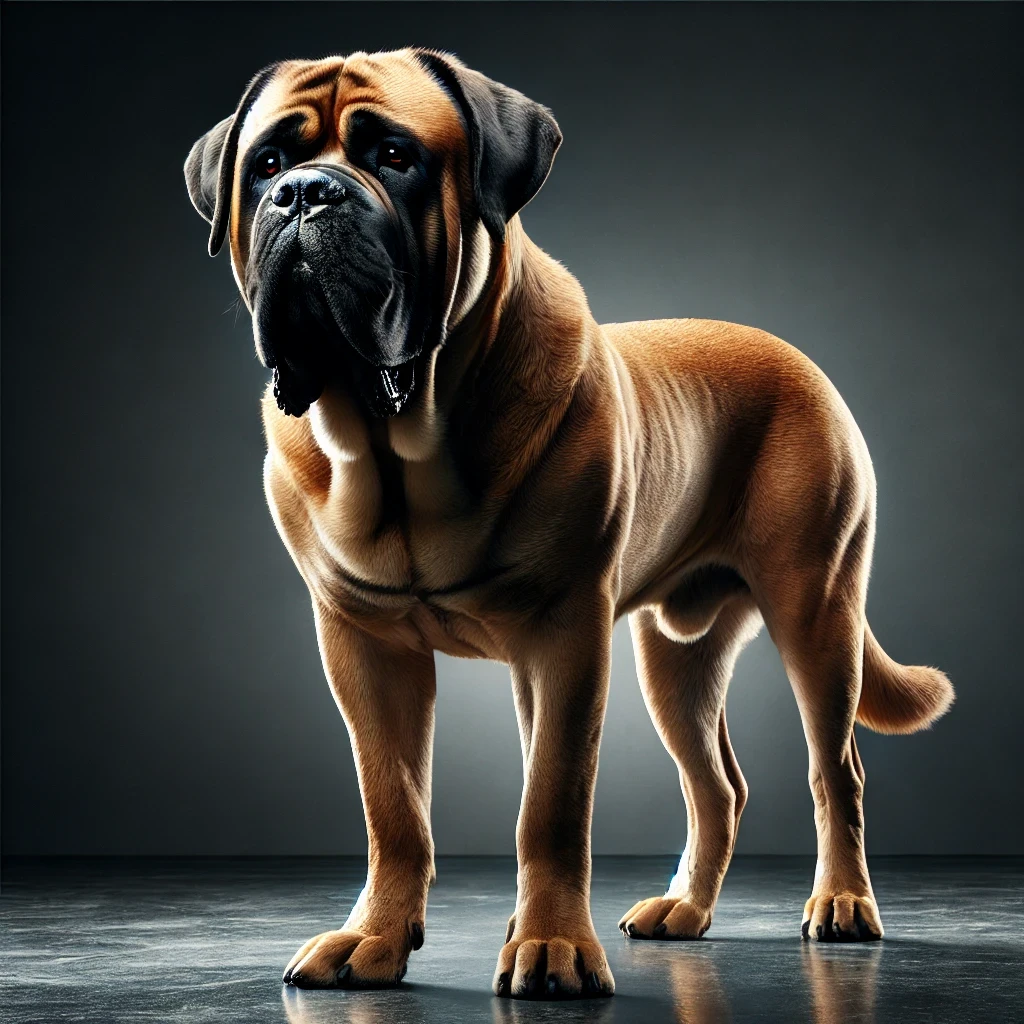If you’re considering this breed or simply curious, this guide breaks down everything you need to know about Mastiff dog breed facts, from their origins and temperament to grooming, training, and fun trivia.

Mastiffs are one of the oldest and most iconic dog breeds in the world. Known for their massive size, calm nature, and loyal disposition, these dogs are often referred to as gentle giants. Despite their intimidating appearance, most Mastiffs are affectionate, patient, and deeply attached to their human families.
History and Origins of the Mastiff
The Mastiff dog breed has a lineage that stretches back thousands of years. Ancient depictions of Mastiff-type dogs appear in Egyptian, Roman, and Chinese records. These dogs were used in war, as guard dogs, and even in Roman arenas during gladiator games.
In medieval England, Mastiffs guarded estates and castles. Over time, the breed became known not only for strength but also for loyalty and protective instincts. The modern Mastiff, often called the English Mastiff, was standardized in Britain and is now celebrated for its affectionate temperament and manageable demeanor in family homes.
Size and Physical Characteristics
Mastiffs are among the largest dog breeds on Earth. A full-grown male can weigh between 160 and 230 pounds, with females typically ranging from 120 to 170 pounds. They stand 27 to 32 inches tall at the shoulder.
They have broad heads, deep muzzles, and expressive eyes that reflect their calm and thoughtful nature. Their short coats come in fawn, apricot, or brindle, often with a dark facial mask.
Explore Poogle Dog Breed Facts
Mastiff Temperament and Personality
One of the most valuable Mastiff dog breed facts is their surprisingly gentle personality. These dogs are calm, affectionate, and extremely loyal.
Mastiff Temperament and Personality
One of the most compelling Mastiff dog breed facts is the contrast between their massive size and their gentle, steady nature. Mastiffs are calm, loving, and incredibly devoted to their families. Despite their imposing appearance, these dogs are often referred to as “gentle giants” for a reason.
Read Pug Dog Breed Facts
Naturally Protective but Not Aggressive
Mastiffs have strong protective instincts, but they are not prone to unwarranted aggression. They are discerning and intelligent, often choosing to observe before they act. Unlike some high-strung guard dogs, Mastiffs take a thoughtful, composed approach. They will rarely bark without a reason, and when they do act to defend their home or people, it is measured and serious.
This makes the Mastiff an excellent family protector—confident and imposing when needed, but never reckless or anxious. Proper training and socialization from a young age help reinforce their natural balance between confidence and calm.
Deeply Loyal and Family-Oriented
One of the most beloved traits in the Mastiff temperament is their intense loyalty. These dogs bond closely with their family members and often form especially strong attachments to one or two people in the household. Once bonded, a Mastiff will follow you around the home, choosing to lie quietly at your feet or observe you from across the room.
Their loyalty runs deep, and they are known to be emotionally sensitive to the mood and energy of their household. If you’re relaxed, they’ll mirror that. If something feels off, they’ll notice before you do.
Read Scottish Terrier Dog Breed Facts
Calm and Low-Key
Unlike many other large breeds, Mastiffs are not hyperactive or excessively playful. They enjoy gentle walks, quiet environments, and quality time with their humans. You won’t often see a Mastiff bouncing off the walls. Instead, they take life at their own pace—slow, steady, and deliberate.
That calm demeanor makes them an excellent fit for more laid-back households. They’re content with a modest level of exercise, provided they get daily interaction and aren’t left alone for extended periods.
Good with Children and Other Pets
Despite their size, Mastiffs tend to be tolerant and patient around children. They often behave in a careful, almost parental way—especially around younger kids. Their strong bodies and stable minds make them less reactive to sudden movements or noises.

However, due to their sheer weight and power, supervision is recommended during playtime to prevent accidental bumps or knocks. Teaching children to respect the dog’s space and body is essential for long-term harmony.
Mastiffs can also get along well with other dogs and household pets when introduced properly. Early socialization helps ensure they grow into well-rounded adults that behave confidently around new animals.
Sensitive and Emotionally Attuned
One often-overlooked Mastiff dog breed fact is how emotionally perceptive they are. These dogs are sensitive to tone of voice, body language, and household energy. Harsh discipline, yelling, or inconsistent routines can easily stress them out. They respond best to calm, confident leadership and positive reinforcement.
Because of this emotional intelligence, Mastiffs often make great companions for individuals or families seeking a loyal, empathetic dog that doesn’t demand constant stimulation.
Training and Socialization
Training a Mastiff requires patience and consistency. They are intelligent but can be stubborn or slow to respond. Positive reinforcement works best. Harsh methods should be avoided as they can lead to withdrawal or anxiety.
Early socialization is key. Expose your Mastiff to a variety of people, pets, and environments during puppyhood. This helps reduce fear-based behaviors and makes them well-adjusted adult dogs.
Learn How Veterinary PPC Helps Dog Owners
Exercise Needs for a Mastiff
Mastiffs are low-energy dogs that need only moderate exercise. Two short walks per day are usually sufficient, along with some time outdoors to stretch and explore.
Avoid over-exercising Mastiff puppies, as their bones and joints are still developing. They can also overheat easily due to their size and should be walked during cooler parts of the day.
Mental stimulation through puzzle toys, basic training, or scent games can also help keep them engaged without physical overexertion.
Grooming and Coat Care
Mastiffs have short, dense coats that require minimal maintenance. Weekly brushing with a rubber grooming mitt helps control shedding and keeps their coat healthy.
They do shed seasonally, so extra brushing may be needed during those times. Bathing every few months is usually enough unless they get especially dirty.
Wrinkle care is important. Clean around their jowls and facial folds regularly to prevent bacterial buildup. Nail trimming, dental hygiene, and ear cleaning should also be part of their grooming routine.
Health Concerns and Lifespan
Large breeds like the Mastiff are prone to specific health concerns. Common issues include:
- Hip and elbow dysplasia
- Gastric torsion (bloat)
- Heart disease
- Progressive retinal atrophy
A study by the Orthopedic Foundation for Animals found that 24 percent of Mastiffs tested showed signs of hip dysplasia. Bloat is also a life-threatening condition that requires immediate veterinary attention.
The average lifespan of a Mastiff is 6 to 10 years. With proper care, diet, and early detection of health problems, many live longer, healthier lives.

Living With a Mastiff
Despite their size, Mastiffs can thrive in apartments or smaller homes, as long as they receive their daily walks and human companionship. They prefer a peaceful environment and do best in homes without too much noise or chaos.
Mastiffs are not ideal for first-time dog owners unless the individual is fully prepared to handle a giant breed. They require consistent leadership, space, and financial preparedness for their food and medical needs.
They are not known for barking excessively, but they will alert you to visitors or unusual sounds. Their presence alone can deter intruders, even if they are gentle by nature.
Fun Mastiff Dog Breed Facts
Beyond their towering size and gentle temperament, Mastiffs have a rich history and a number of quirky, fascinating traits that make them one of the most interesting large dog breeds in the world. These fun Mastiff dog breed facts highlight just how unique and impressive this ancient breed truly is.
Here are some lesser-known and fascinating Mastiff dog breed facts:
1. The Heaviest Dog Ever Was a Mastiff
One of the most jaw-dropping Mastiff dog breed facts: the heaviest dog ever recorded was an English Mastiff named Zorba. In 1989, Zorba tipped the scales at an astonishing 343 pounds and stretched over 8 feet long from nose to tail. He remains a symbol of the breed’s incredible size and strength.
2. Mastiffs Have a Military Legacy
Mastiffs were once used as war dogs by ancient civilizations. The Babylonians, Greeks, and Romans all utilized Mastiff-type dogs in battle. Roman legions even equipped them with armor and sent them charging into enemy lines. These dogs were prized for their strength, loyalty, and fearlessness.
3. The Breed Nearly Went Extinct
After World War II, the Mastiff population in England was nearly wiped out. By the late 1940s, only a handful of Mastiffs remained in the country. The breed was slowly revived through careful breeding programs—often using Mastiffs from North America to rebuild the population. Today’s Mastiff owes much of its survival to this international effort.
4. Mastiffs Are “Leaners”
If you’ve ever owned a Mastiff, you’ve likely experienced this first-hand: Mastiffs are leaners. They often press their large bodies against your legs as a sign of trust and affection. It’s their version of a full-body hug—and when a 150-pound dog leans, you’ll definitely feel the love.
Read Cost of a Vet Visit for Dogs: What Owners Should Expect
5. They Rank Among the Most Popular Giant Breeds
According to the American Kennel Club (AKC), the Mastiff consistently ranks within the top 30 most popular dog breeds in the United States. Despite their massive size, their calm demeanor, family loyalty, and protective instincts make them a top choice for experienced dog owners seeking a large but affectionate companion.
6. Mastiffs Are Surprisingly Quiet
Unlike many other watchdogs, Mastiffs are not prone to excessive barking. They are observant and discerning, often choosing silence unless they perceive a real threat. This trait makes them excellent home guardians who won’t disrupt the peace with unnecessary noise.
7. Mastiffs Have a Long Lifespan for Their Size
For such a large dog, Mastiffs have a relatively decent lifespan. With proper care, many Mastiffs live between 8 to 10 years, and some reach 11 or 12 years. Routine vet visits, a balanced diet, and moderate exercise are key to extending their longevity.
8. Mastiffs Have Been Featured in Literature and Pop Culture
The Mastiff has appeared throughout history in art, literature, and pop culture. From Shakespeare’s plays to modern films and television, the breed’s noble and stoic presence has made it a favorite symbol of strength and loyalty.
Be Prepared For The First Vet Visit Puppy Guide
Is a Mastiff Right for You?
The Mastiff is a loving, loyal companion that thrives in calm households where it can bond closely with its family. While their size can be daunting, their personalities are gentle and affectionate.
If you have the space, the time, and the desire to care for a large, low-energy dog that will become deeply attached to you, the Mastiff could be an ideal fit. They offer steadfast companionship, a noble presence, and years of unconditional love.
Visit Dog Breed Facts
